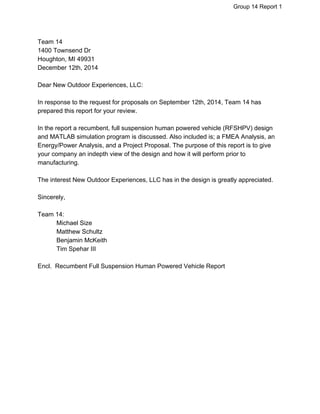
Eng1102Team14TrikeReport
- 17. Group 14 Report 17 Appendix Team 14 Project Report Enclosures: ● Cannondale Investigation PowerPoint
- 28. Group 14 Report 28 AAA=load('b2013_08_23_0930.dat'); elseif a==8 AAA=load('b2013_08_23_1028.dat'); elseif a==9 AAA=load('b2013_08_23_1312.dat'); elseif a==10 AAA=load('b2013_10_10_1530.dat'); end elev=AAA(:,3); dist=AAA(:,4); lat=AAA(:,1); lon=AAA(:,2); hr=AAA(:,5); vel=AAA(:,6); end %User chooses a data file of data taken from 10 different athletes. Data %for longitude, lattitude, elevation, distance, heart rate and velocity, %was taken at every second. The program then determines the change in %veolcity and distance. From there it calculates aceleration. After that %the total distance traveled and the total elevation gain are found, so %that the slope angle may be calculated. The slope angle is then used to %calculate some different types of forces. The program then calculates %power and calories being burned. From calculations and gearing information %brought into from the gearing function. %11 December 2014 %Ben McKeith, Tim Sephar, Michael supersize, Matt Schultz clc clear %call for the user to choose the data set a=input('This program has been written to run, and simulate vehicle andn rider performance, this data was collected for 10 differentn athletes. Choose a data set to use (110): ');
- 32. Group 14 Report 32 Vel_n=0; else Vel_n(i)=D_Dis(i)/DT(i); end if Vel_n==0 Acc_n=0; else Acc_n(i)=Vel_n(i)/DT(i); tot_time=tot_time+DT(i); end f_slope_n(i)= mass_total*gravity*sin(slope_angle); for i=1: length(Vel_n); if Vel_n(i)<=0; Vel_n(i)=.1; end f_bump_n(i)=P_b./Vel_n(i); f_air_n(i)=(.5)*p*A*C_d*power(Vel_n(i),2); f_roll_n(i)=C_r*mass_total*gravity*cos(slope_angle); tot_force= (mass_total* Acc_n(i)) + f_air_n(i) + f_slope_n(i) + f_roll_n(i) + f_bump_n(i); w_rpm(i) = Vel_n(i)/(29*pi*0.0254/60); end end pos_p_rider = 0; pos_p_rider_count=0; for i=1: length(p_rider) if p_rider(i) >= 0 pos_p_rider = pos_p_rider + p_rider(i); pos_p_rider_count = pos_p_rider_count +1; end end VPR = pos_p_rider / pos_p_rider_count; total_cals=VPR*tot_time/1000/4.18; total_time_hours=tot_time/60/60; end %gearing function call cad_trg=input('Enter preferred cadence target in rpm *4080*: ');